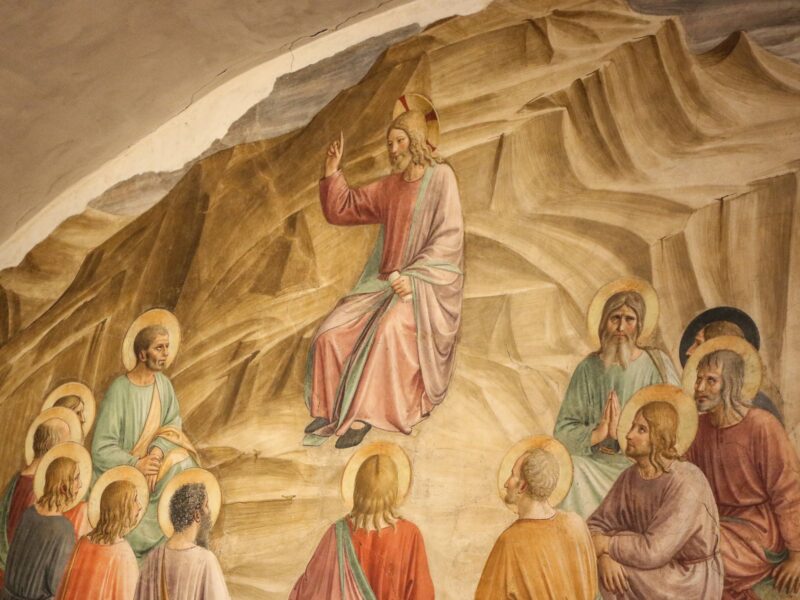
Why Shepherds?
Christmas. Fr Fergus Kerr preaches on the visit of the shepherds to the infant Jesus.
The first visitors to the infant Jesus that St Matthew mentions are ‘wise men from the East’, the Magi, led by their astrology, and consultation via King Herod with the chief priests and scribes. No doubt Matthew assumes they came from Persia or Babylon (Iran or Iraq), perhaps priests of the Zoroastrian religion (represented today by the Parsees in India) — perhaps signalling an ‘inter-faith’ dimension, so to speak, which culminates in the Lord Jesus’s last words — ‘Go and make disciples of all nations’ (Matt 28:19).
According to St Luke, however, the first to visit the infant Jesus were shepherds, minding their flocks near Bethlehem. They come as a result of pure revelation. They are surrounded by the glory of the Lord, terrified, told not to be afraid, and so on, the usual circumstances for an angelic message.
‘The good news of great joy for all the people’, they are told, is that ‘there is born this day in the City of David a Saviour, who is Christ the Lord’. They consulted among themselves, decided to go into the city, found Mary and Joseph and Jesus, and ‘made known what had been told them about this child’ — at which ‘all were amazed’, while Mary ‘treasured it all and pondered it in her heart’.
Over the centuries, obviously, Matthew’s Magi have largely eclipsed Luke’s shepherds. Indeed, if relics were the measure of fame, there is no contest. The relics of the Magi may be visited in a wonderfully embellished shrine in Cologne cathedral, where they have been since 1162 as part of the loot brought back from Italy by the Holy Roman Emperor Frederick Barbarossa.
After the Reformation, the shepherds pop up in Christmas hymns, such as ‘While shepherds watched their flocks by night, all seated on the ground’, by the Irish Protestant Nahum Tate (1652-1715).
But why shepherds?
One story goes as follows. Luke, it is claimed, is the Evangelist who makes the ‘option for the poor’ his central theme. Hitherto excluded people are now to be honoured, and outsiders to be brought into the community, such as tax collectors, women, and the poor — the first of whom, then, would be the shepherds. For, according to some Jewish writings, herdsmen were on the list of those ineligible to be witnesses in legal cases since they grazed their flocks on other people’s lands and were thus (like tax collectors) archetypal sinners.
The more classes of people the Pharisees excluded, the more inclusive Jesus looks. Shepherds have to be brought in from the cold.
Fine — except that, throughout the Bible, shepherds have a very positive profile. We hear a great deal about wicked shepherds, it’s true, especially in Ezekiel, feeding themselves rather than the flock, clothing themselves with wool and slaughtering the fat sheep, and so on. But such savage critiques only confirm the importance of the shepherd imagery that applies to leaders, whose task lies in protecting and guiding their people as a shepherd tends his flock.
The Lord himself is our shepherd (Psalm 23). Among biblical ‘heroes’, Moses, Jacob and of course David, were all literally shepherds, if not for very long, and then figuratively so, in their own histories and especially in subsequent iconography. The shepherd symbolism is everywhere.
Why should it not seem fitting, then, to St Luke, to highlight shepherds as the ones who were divinely chosen to identify the infant Jesus, born in the city of David, near where they tended their sheep?
After all, it was to Bethlehem that the prophet Samuel came in search of a king over Israel: Jesse’s youngest son David had to be summoned, indeed, precisely from keeping the sheep (see 1 Samuel 17). Perhaps Luke expected us to assume that, when the angel revealed the good news to them, the shepherds were out in the fields in which David once tended his family’s flock.
No great leap of imagination is required to conclude that, for Luke, shepherds were the most appropriate class of people to visit the child first — the child descended from David, who inherited the throne of David, the shepherd king, and who would, in due time, identify himself as the Good Shepherd (John 10).
In short, the revelation to the shepherds in the hills outside royal David’s city seems to embed Jesus from the beginning within this pervasive biblical shepherd imagery and symbolism.
Perhaps we need not choose between these two interpretations. The option for the poor is not incompatible with the identification of the shepherd-king — on the contrary, ‘The good shepherd lays down his life for the sheep’ (John 10:11).
Yet, it surely makes a difference: are the shepherds the first of the despised sinners whom Christ brings into communion with himself, or are they the heralds of the good news that the shepherd has come who will feed his flock, gather the lambs in his arms and carry them in his bosom and gently lead those that are with young (Isaiah 40: 13)?
The shepherds returned to their flocks ‘glorifying and praising God for all that they had heard and seen’. What they had heard and seen was surely, in the incomparable old metaphor, the birth of the shepherd who would care for his flock throughout their lives, through the valley of the shadow of death, and even beyond, in the ‘house of the Lord for ever’ (Psalm 23).


